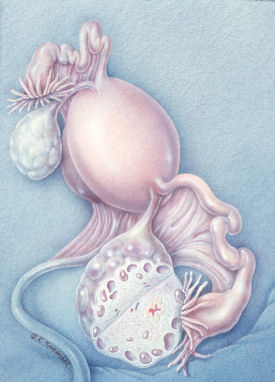Test Yourself: MKSAP Quiz
A 32-year-old man comes to the office after being told at a health fair screening that he had blood in his urine. He states that he has never seen gross blood in his urine and has not passed any kidney stones. He does not smoke cigarettes and takes no medications.
On physical examination, pulse rate is 72/min and blood pressure is 138/78 mm Hg.
Laboratory Studies
| Hemoglobin | 13.8 g/dL (138 g/L) |
| Leukocyte count | 6800/μL (6.8 × 109/L) |
| Platelet count | 325,000/μL (325 × 109/L) |
| Blood urea nitrogen | 12 mg/dL (4.29 mmol/L) |
| Creatinine | 1.1 mg/dL (97.26 μmol/L) |
| Sodium | 138 meq/L (138 mmol/L) |
| Potassium | 4.2 meq/L (4.2 mmol/L) |
| Bicarbonate | 25 meq/L (25 mmol/L) |
| Calcium | 10.1 mg/dL (2.52 mmol/L) |
| Phosphorus | 4.2 mg/dL (1.36 mmol/L) |
| Urinalysis pH 5.0, specific gravity | 1.010, 2+ blood, 2+ protein, 5–10 dysmorphic erythrocytes/hpf |
| Urinary protein–creatinine ratio | 1500 mg/g |
Which of the following is the most likely cause of this patient's hematuria?
A. Genitourinary tract malignancy
B. Urinary tract infection
C. Nephrolithiasis
D. Glomerulonephritis
Answer and critique
Correct Answer D: Glomerulonephritis
This is available to MKSAP 14 subscribers in Nephrology, item 88.
Glomerulonephritis is the most likely cause of this patient's hematuria. Hematuria is a common finding that occurs in 1% to 3% of all patients and in as many as 10% of all men. One of the most important initial steps in the evaluation of microscopic hematuria is microscopic analysis of urine sediment to assess erythrocyte morphology to distinguish between glomerular and nonglomerular hematuria of the urinary tract. Monomorphic or intact erythrocytes characterize nonglomerular hematuria, whereas dysmorphic erythrocytes are associated with glomerular hematuria. The coexistence of proteinuria with hematuria and the presence of erythrocyte casts in this patient indicate a diagnosis of glomerulonephritis.
Genitourinary tract malignancy is more common in men >50 years of age who have persistent hematuria and risk factors such as cigarette smoking, analgesic abuse, benzene exposure, or a history of voiding abnormalities. Urinary tract infection is an uncommon condition in men without associated anatomic abnormalities and is not associated with glomerular hematuria and proteinuria. Nephrolithiasis is a common cause of hematuria but is unlikely in a patient without symptoms associated with this condition, such as flank pain. This patient's findings of glomerular hematuria and proteinuria on microscopic analysis of the urine sediment also do not suggest nephrolithiasis.
Key Points
- One of the most important initial steps in the evaluation of microscopic hematuria is urine microscopy to assess erythrocyte morphology.
- Glomerular hematuria is associated with dysmorphic erythrocytes and erythrocyte casts on urinalysis.




